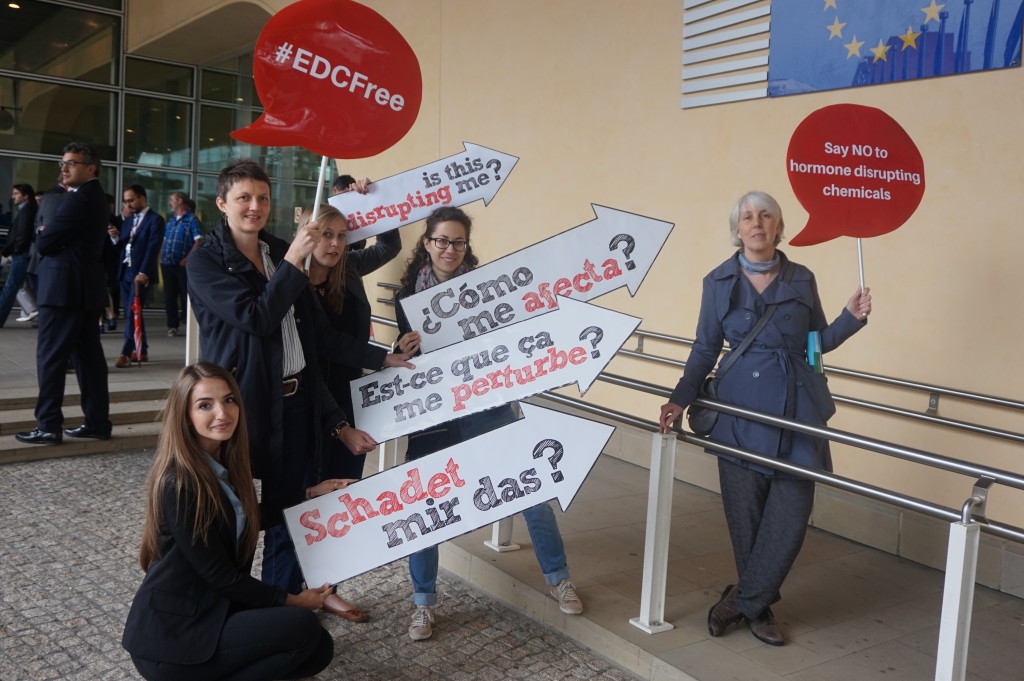Say “No” to hormone disruption, say “Yes” to citizens’ wishes
Partners in the EDC-Free coalition gathered outside the European Commission building at Berlaymont in Brussels on Monday, 13 June. They called for more attention to be given to citizens’ wishes and independent science in EU decisions on endocrine disrupting chemicals (EDCs).

Lisette van Vliet, Senior Policy Adviser at the Health and Environment Alliance (HEAL), calls on European Commission President Jean-Claude Juncker and his 27 Commissions to protect health from exposure to hormone, or endocrine, disrupting chemicals, which are found in everyday products.
The EDC-Free coalition anticipates that the Commission will come forward with its proposal on the scientific criteria for identifying EDCs on Wednesday, 15 June. HEAL’s Lisette van Vliet is ready to answer questions on the citizens’ perspective and issue a call to action on EDCs. She says: “There exists a scientific consensus on how best to identify these harmful chemicals. We want the EU to choose the best criteria and make the best use of the science to distinguish between them. This means sticking with the successful practice used to rank other harmful chemicals (1) into at least three categories.”
She will also talk about the recent vote in the European Parliament which overwhelmingly condemned the Commission for its failure to comply with the original deadline and thus with the EU Treaty. Sweden, working with several other Member State governments, the European Parliament and the European Council took the Commission to court and won. The European court judgement made clear that the impact assessment can have no bearing on the decision about which scientific identification criteria are chosen.
On June 20, the Council of Environment Ministers will discuss the EDCs criteria. (2)
The health costs of diseases associated with exposure to endocrine disrupting chemicals, including infertility and male reproductive dysfunctions, female reproductive problems (endometriosis and uterine fibroids), birth defects, obesity, diabetes, cardiovascular disease, and neurobehavioral and learning disorders, have been estimated at 158.4 billion Euros per year in the EU. (3)
Contacts:
Lisette van Vliet, Senior Policy Adviser, Health and Environment Alliance (HEAL), Mobile: +32 484 614 528, Email: lisette@env-health.org
Lucy Mathieson, Communications Manager, Health and Environment Alliance (HEAL), Mobile: +32 470 84 75 73, Email: lucy@env-health.org
Notes for journalists:
- Carcinogens, mutagens and reproductive toxicants
- The discussion in the Council was requested by France, which has a strong position on the criteria. (France had also joined Sweden in the court case.) Once the criteria have been endorsed by the EU Commissioners, the Commission must submit them to a standing committee on pesticides, and the Commission has also chosen to consult an expert group on biocides, probably in early July. The subsequent text would then be presented to Parliament and Council for approval or rejection, before returning to the Commission for final publication (or for the whole process to be re-started).
- Two recent studies have analysed the economic impact that exposure to endocrine-disrupting chemicals may be having on health. The first estimated costs at 157 billion Euros a year (taking into account impacts on infertility and male reproductive dysfunctions, birth defects, obesity, diabetes, cardiovascular disease, and neurobehavioral and learning disorders associated with certain endocrine disrupting chemicals) see http://press.endocrine.org/doi/10.1210/jc.2014-4324. The second estimated costs associated with two female reproductive health conditions, endometriosis and uterine fibroids attributable to certain EDCs, at 1.4 billion Euros per year. Clin Endocrinol Metab. 2016 Mar 22. doi: 10.1210/jc.2015-2873. See https://www.endocrine.org/news-room...
